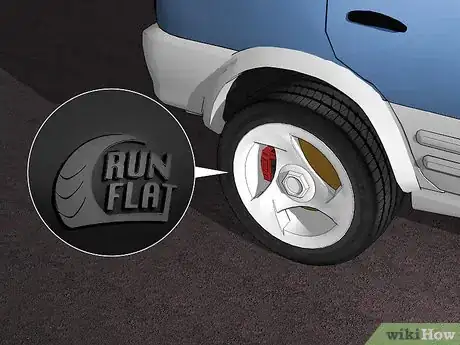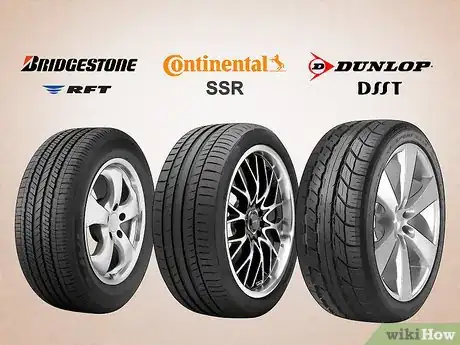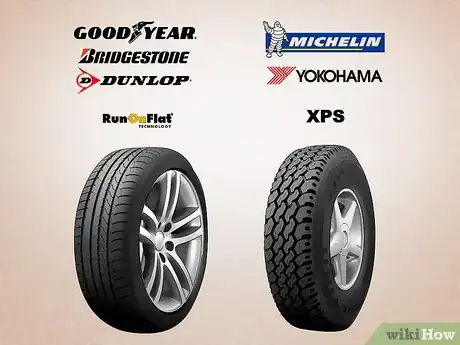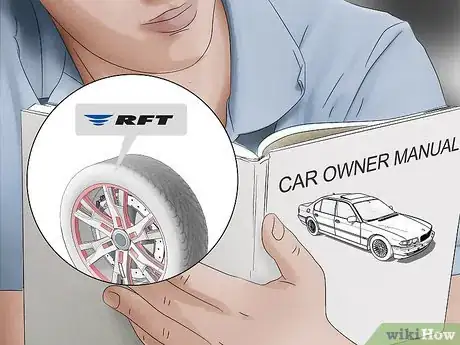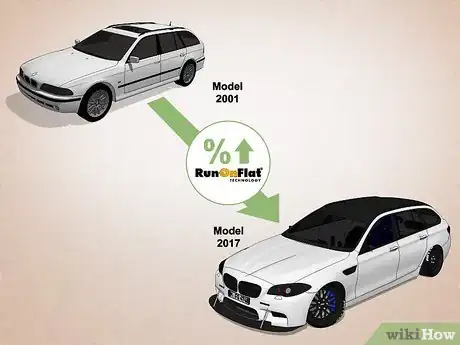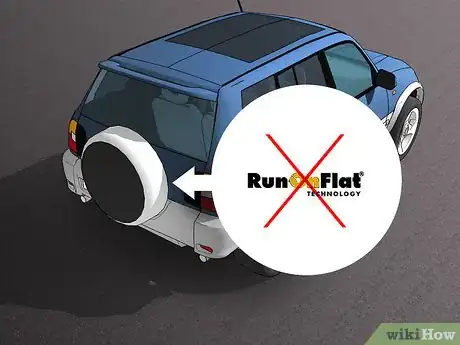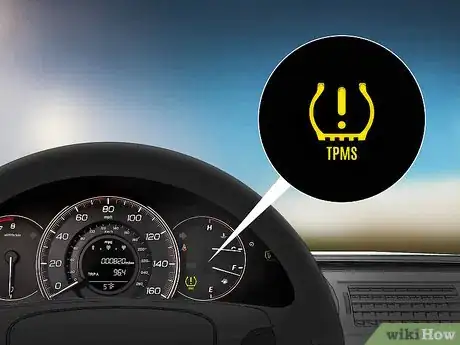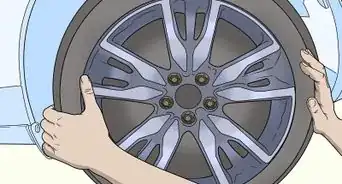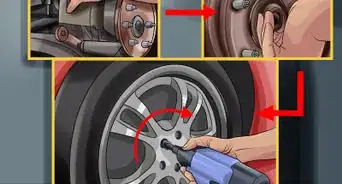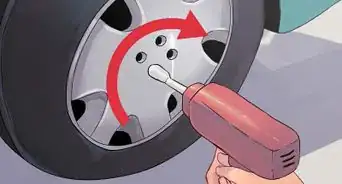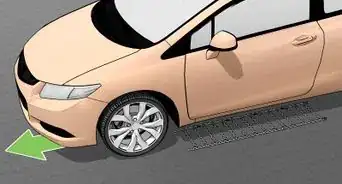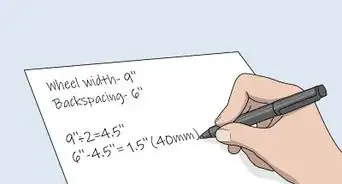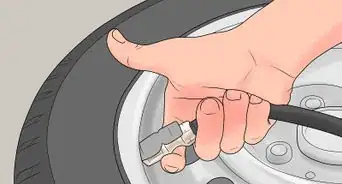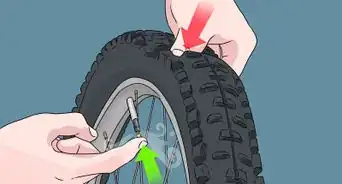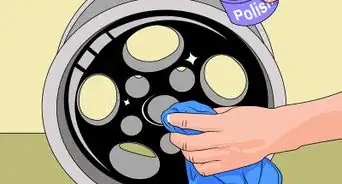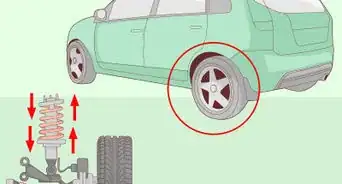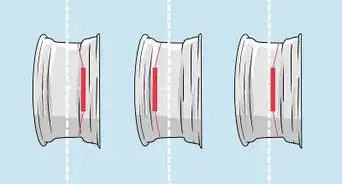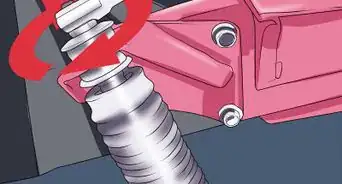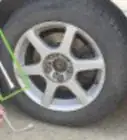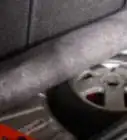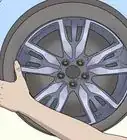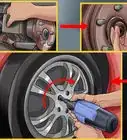This article was co-authored by wikiHow Staff. Our trained team of editors and researchers validate articles for accuracy and comprehensiveness. wikiHow's Content Management Team carefully monitors the work from our editorial staff to ensure that each article is backed by trusted research and meets our high quality standards.
This article has been viewed 179,275 times.
Learn more...
Run-flat tires are tires that can be driven “flat” for a distance after they've been punctured at a reduced speed, allowing you some time to drive to a mechanic. The distance and speed that run-flat tires can handle after being punctured depends on the brand of tire and the weight that the car is currently holding. You can usually tell if your tires are run-flat by looking at your tires, or by examining other details about your car.
Steps
Checking Your Tires
-
1Find the words “Run Flat” on your tires. Some tire brands that make run-flat tires simply label the tire as run flat, making it easier on the car owner. Pirelli tires is one brand that does this.
- Simply look for the words “Run Flat” on the side of your tire, usually near other manufacturer information and numbers.[1]
-
2Look for the codes RFT, SSR, or DSST on your tires. Bridgestone sometimes uses the code RFT (Run Flat Tire) on their tires to designate a run-flat tire. Continental uses the code SSR (Self Supporting Run flat), and Dunlop sometimes uses DSST (Dunlop Self Supporting Tire).
- Look for these codes on the sides of your tires near the other numbers and manufacturer information.[2]
Advertisement -
3Look for the codes ROF, EMT, or ZP on your tires. Several tire brands use the code ROF (Run On Flat) on their run-flat tires, including Goodyear, Bridgestone, and Dunlop. Goodyear also uses EMT (Extended Mobility Technology) to designate run-flat tires. A few brands use ZP or ZPS (Zero Pressure or Zero Pressure System) on their run-flat tires, including Michelin and Yokohama.
- Look for any of these codes on the sides of your tires near the manufacturer information.[3]
Looking at a Car with Original Tires
-
1Check your car owner’s manual. The most direct way to find out if you have run-flat tires is to check your owner’s manual. If your car still has its original tires and they are run-flat, the owner’s manual will explain everything you need to know about your run-flat tires and the TPMS (Tire Pressure Monitoring System).[4]
-
2Look for run-flat tires on newer cars made by specific companies. Run-flat tires started coming onto the new car market in the early 2000s. The newer your car is, the higher the chances are that it came with run-flat tires.
- Specific car companies more commonly use run-flat tires on their new cars, especially BMW and Lexus. Toyota puts run flat-tires on some of their coupes and sedans. If you have one of these types of cars with original tires on it, it’s possible that you have run-flat tires.
- BMW cars are by far the most common car where you will find run-flat tires. If you have a newer BMW, chances are high that you have run-flat tires.
-
3See if your car comes with a spare tire or not. A car with original run-flat tires on it will not come with a spare tire in the trunk. If your car comes with a tire repair kit in the trunk instead of a spare tire, it’s possible that you have run-flat tires.
- If you’re still not sure, ask the dealer or check in your owner’s manual to find out.[5]
-
4Look at the driver’s side dashboard for a tire pressure warning light. Cars fitted with run-flat tires also have a Tire Pressure Monitoring System, which monitors the air pressure in the tires. If your air pressure is low, a light will come on that alerts you about the low pressure.
- Your owner’s manual will explain where to look for this warning and what to do if it lights up.[6]
Community Q&A
-
QuestionCan a Cooper Star-fire RS-C 2.0 All-Season Radial Tire run flat?
 Community AnswerThe Cooper Star-Fire RS-C 2.0 is not a specific run flat tire. Run flat tires have a thicker sidewall, in order to be driven to the nearest automotive repair shop for repair or to be replaced. Driving on any flattened or flattening tire is not suggested, and can be highly dangerous.
Community AnswerThe Cooper Star-Fire RS-C 2.0 is not a specific run flat tire. Run flat tires have a thicker sidewall, in order to be driven to the nearest automotive repair shop for repair or to be replaced. Driving on any flattened or flattening tire is not suggested, and can be highly dangerous. -
QuestionWhat Run Flat code is used by Hankook tyres?
 Community AnswerHRS at the end of the product model description on the sidewall of the tire.
Community AnswerHRS at the end of the product model description on the sidewall of the tire. -
QuestionDo run flat tyres have tubeless stamped on them?
 DylanstmartinCommunity AnswerAny modern car tire is tubeless. So the chances of it having a tubeless stamping can be possible. Run flat tires typically have "Run Flat" stamped on them other common abbreviations are "ZP", "RFT", "SEAL".
DylanstmartinCommunity AnswerAny modern car tire is tubeless. So the chances of it having a tubeless stamping can be possible. Run flat tires typically have "Run Flat" stamped on them other common abbreviations are "ZP", "RFT", "SEAL".
References
- ↑ https://www.theaa.com/driving-advice/safety/run-flat-tyres
- ↑ https://www.national.co.uk/information/run-flat-tyres
- ↑ https://www.blackcircles.com/helpcentre/tyres/how-do-i-know-if-my-tyres-are-run-flat-tyres
- ↑ https://www.arrivealive.co.za/Run-Flat-Tyre-Technology-and-Road-Safety
- ↑ https://www.autoguide.com/auto-news/2012/05/run-flat-tires-why-you-should-or-shouldnt-buy-them.html
- ↑ https://www.autoguide.com/auto-news/2012/05/run-flat-tires-why-you-should-or-shouldnt-buy-them.html
About This Article
To check if your car has run flat tires, the most direct method would be to read through the owner’s manual, which is probably stored in the glove compartment. If you still have the original tires on the car, then the information in the owner’s manual should be accurate, and you can follow whatever instructions are given there. If you don’t have access to the owner’s manual or if the tires are not original to the car, you can also check to see if one of several coded markings is found on your tire. The mark, which is specific to the brand, can be found on the side of the tire near the manufacturer’s information and numbers. Some of the common codes are “Run Flat,” “RFT,” “SSR,” “DSSR,” “ROF,” “EMT,” OR “ZP.” To learn how to check for run-flat tires by checking other parts of the car, keep reading.
